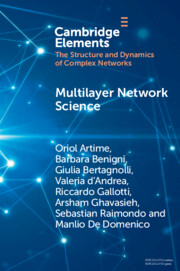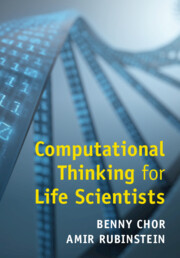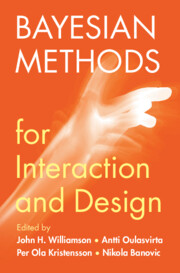Refine search
Actions for selected content:
48294 results in Computer Science
16 - One Numerical Sample
- from Part III - Elements of Statistical Inference
-
- Book:
- Principles of Statistical Analysis
- Published online:
- 22 July 2022
- Print publication:
- 25 August 2022, pp 230-270
-
- Chapter
- Export citation
10 - Cue Integration in Input Performance
- from Part IV - Bayesian Cognitive Modelling
-
- Book:
- Bayesian Methods for Interaction and Design
- Published online:
- 18 August 2022
- Print publication:
- 25 August 2022, pp 287-307
-
- Chapter
- Export citation
6 - Statistical Keyboard Decoding
- from Part II - Probabilistic Interfaces and Inference of Intent
-
- Book:
- Bayesian Methods for Interaction and Design
- Published online:
- 18 August 2022
- Print publication:
- 25 August 2022, pp 188-211
-
- Chapter
- Export citation
Preface
-
- Book:
- Principles of Statistical Analysis
- Published online:
- 22 July 2022
- Print publication:
- 25 August 2022, pp xiv-xvi
-
- Chapter
- Export citation
Comparing the creamatocrit of human milk before and after long-term freezing
-
- Journal:
- Experimental Results / Volume 3 / 2022
- Published online by Cambridge University Press:
- 24 August 2022, e11
-
- Article
-
- You have access
- Open access
- HTML
- Export citation
The development, and day-to-day variation, of a Military-Specific Auditory N-Back Task and Shoot-/Don’t -Shoot Task
-
- Journal:
- Experimental Results / Volume 3 / 2022
- Published online by Cambridge University Press:
- 24 August 2022, e15
-
- Article
-
- You have access
- Open access
- HTML
- Export citation
Crisis as driver of digital transformation? Scottish local governments’ response to COVID-19
-
- Journal:
- Data & Policy / Volume 4 / 2022
- Published online by Cambridge University Press:
- 24 August 2022, e26
-
- Article
-
- You have access
- Open access
- HTML
- Export citation
Recognition of visual scene elements from a story text in Persian natural language
-
- Journal:
- Natural Language Engineering / Volume 29 / Issue 3 / May 2023
- Published online by Cambridge University Press:
- 24 August 2022, pp. 693-719
-
- Article
- Export citation

Multilayer Network Science
- From Cells to Societies
-
- Published online:
- 23 August 2022
- Print publication:
- 15 September 2022
-
- Element
- Export citation
Positive Dependency Graphs Revisited
-
- Journal:
- Theory and Practice of Logic Programming / Volume 23 / Issue 5 / September 2023
- Published online by Cambridge University Press:
- 23 August 2022, pp. 1128-1137
-
- Article
-
- You have access
- Open access
- HTML
- Export citation
Motion design and visual communication in the era of ‘diffuse design’ paradigm: analysis and evaluation of a didactic experiment
-
- Journal:
- Design Science / Volume 8 / 2022
- Published online by Cambridge University Press:
- 23 August 2022, e22
-
- Article
-
- You have access
- Open access
- HTML
- Export citation
Trajectory design via unsupervised probabilistic learning on optimal manifolds
-
- Journal:
- Data-Centric Engineering / Volume 3 / 2022
- Published online by Cambridge University Press:
- 23 August 2022, e26
-
- Article
-
- You have access
- Open access
- HTML
- Export citation
Idea selection in design teams: a computational framework and insights in the presence of influencers
-
- Journal:
- Design Science / Volume 8 / 2022
- Published online by Cambridge University Press:
- 23 August 2022, e23
-
- Article
-
- You have access
- Open access
- HTML
- Export citation
Quantifying the impact of context on the quality of manual hate speech annotation
-
- Journal:
- Natural Language Engineering / Volume 29 / Issue 6 / November 2023
- Published online by Cambridge University Press:
- 22 August 2022, pp. 1481-1494
-
- Article
-
- You have access
- Open access
- HTML
- Export citation
Extracting functional programs from Coq, in Coq
-
- Journal:
- Journal of Functional Programming / Volume 32 / 2022
- Published online by Cambridge University Press:
- 22 August 2022, e11
-
- Article
-
- You have access
- Open access
- HTML
- Export citation

Computational Thinking for Life Scientists
-
- Published online:
- 19 August 2022
- Print publication:
- 08 September 2022

Bayesian Methods for Interaction and Design
-
- Published online:
- 18 August 2022
- Print publication:
- 25 August 2022
Part III - Generative Models
-
- Book:
- The Science of Deep Learning
- Published online:
- 23 September 2022
- Print publication:
- 18 August 2022, pp 151-152
-
- Chapter
- Export citation


